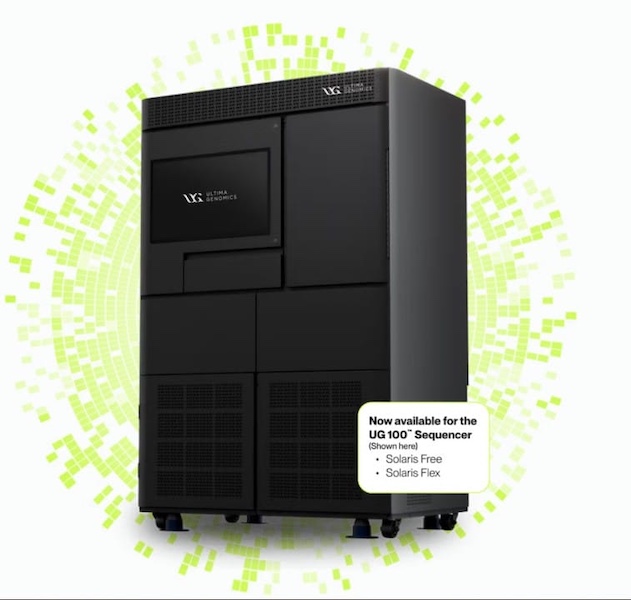Summary:
Ultima Genomics has launched UG 100 Solaris, an upgraded sequencing solution that enhances throughput, reduces costs, and maintains high accuracy, with Early Access also available for Solaris Boost to support large-scale omics applications.
Takeaways:
- Enhanced Efficiency & Cost Reduction – the solution introduces new chemistry and software, increasing sequencing output while lowering costs.
- High Accuracy & Expanded Workflows – The platform ensures ppm-level accuracy (SNVQ60) and supports both PCR-free and amplified libraries.
- Scaling for Large-Scale Genomics – Solaris Boost offers high-throughput sequencing, reaching up to 100 billion reads per day for population-scale studies.
Ultima Genomics, Inc., a developer of an ultra-high-throughput sequencing architecture, announced the commercial launch of UG 100 Solaris. UG 100 Solaris features new chemistry, software, and simplified workflows to significantly increase output and lower cost on the UG 100 sequencing platform.
“Only one year after commercially launching our UG 100 sequencing platform, we are excited to announce another major leap forward in our product evolution with the launch of UG 100 Solaris, providing even higher throughput, lower cost, and broader support for key applications technologies on our UG 100 sequencing platform,” says Gilad Almogy, founder and CEO of Ultima Genomics. “UG 100 Solaris showcases the scalability of our unique architecture and represents the first step to decreasing the cost of sequencing and increasing the scale of genomics data.”
UG 100 Solaris Delivers High-Quality Data and Accuracy
The workflows now commercially available with the launch of UG 100 Solaris include Solaris Free for PCR-free libraries, and Solaris Flex for amplified and converted libraries. Beyond the increase in output, decrease in cost, and other improvements enabled for the UG 100 Sequencer, the solution also provides the same high-quality data and extreme accuracy with Ultima’s ppmSeq technology-enabling part-per-million accuracy, or SNVQ60, for calling single nucleotide variants (SNVs).
To date, Solaris has been deployed at more than 15 customer sites, garnering strong feedback:
“The UG 100 has really transformed the way we approach high-depth projects,” says Kenny Beckman, Director at the University of Minnesota Genomics Center. “At the per read cost of the new Solaris chemistry, we are simply replacing sequence capture with whole-genome sequencing. We have been amazed to see, in our initial projects, that it’s less expensive — not to mention way simpler — to sequence the whole human genome at 30X than to carry out a capture of just 1/1000th of it. The resulting data is free of the compromises that we have with sequence capture. For model organism genomes like Drosophila, where our 30X WGS cost is now just a few dollars, we see a path to 30X WGS as an everyday means to characterize variants and genome edits. The possibilities are endless.”
Boosting Large-Scale Short Read Applications
The company also announced Early Access for UG 100 Solaris Boost. Solaris Boost is a new high-throughput operating mode that enables true population-scale omics and large-scale data generation. By reducing sequencing run times, UG 100 Solaris Boost can further increase the output of the sequencing platform to up to 100 billion reads per day for short-read applications. The company has begun installing UG 100 Solaris Boost at selected Early Access sites and will provide additional details on full commercial availability in 2025.
“Since the company’s inception, we have advanced our innovative sequencing architecture to enable the generation of genomic data at a scale previously not possible with legacy platforms,” says Almogy. “Solaris Boost is an excellent example of the scaling possibility with our flexible sequencing architecture, and this feature will enable data-hungry applications.”
Featured Image: UG 100 Solaris features new chemistry, software, and simplified workflows to significantly increase output and lower cost on the UG 100 sequencing platform. Image: Ultima Genomics





